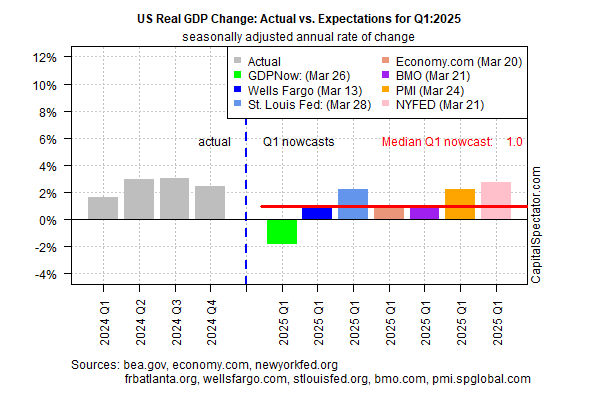UBS says use dips to add gold exposure as prices could reach $4,700
Economic output is estimated to downshift sharply in next month’s official GDP report for the first quarter, based on the median nowcast from several sources. Recessionary conditions will likely be avoided, at least for now, but Q1 data appears set to highlight an increased vulnerability in Q2 and beyond.
Output is set to rise a weak 1.0% in the first quarter (annualized real rate), according to the median nowcast. If correct, growth will slow substantially from Q4’s 2.4% advance. The Bureau of Economic Analysis is scheduled to publish its initial Q1 report on Apr. 30.

Today’s estimate for 1.0% growth in Q1 marks a slight downshift from the previous 1.2% nowcast, published on Mar. 18. That’s worrisome because the longer the subdued nowcast persists, the higher the odds for a material slowdown from Q4.
Despite the expected slowdown in economic activity, it’s still premature to assume that a recession is fate. Although the warning signs are building, several real-time indicators of the business cycle continue to signal a growth bias.
Analysis by TMC Research, for example, notes: “Several economic indicators that are updated frequently suggest the start of a US recession still doesn’t look like a high risk in the immediate future. The relatively upbeat profile is based on hard data via three sources: Dallas Fed’s Weekly Economic Index (WEI), Philadelphia Fed’s ADS Index, and the Labor Dept’s weekly jobless claims report. Recent surveys paint a more worrisome outlook, but until the hard data agrees it’s reasonable to view recession forecasts cautiously.”
Uncertainty related to tariffs, which are set to kick in on Apr. 2, are persuading economists to downgrade their economic outlook. “A lot of the uncertainty about tariffs very likely has firms sort of frozen in place as they’re waiting to evaluate and see what happens,” says Jason Miller, a professor of supply chain management at Michigan State University.
One-quarter of US businesses has scaled back hiring plans due to concerns about a trade war, according to a survey of chief financial officers published this week by Duke University and the Federal Reserve Banks of Richmond and Atlanta. “Tariffs are first-order concern. At least in the short run, they are a great risk,” says John Graham, professor of finance at Duke’s Fuqua School of Business.
